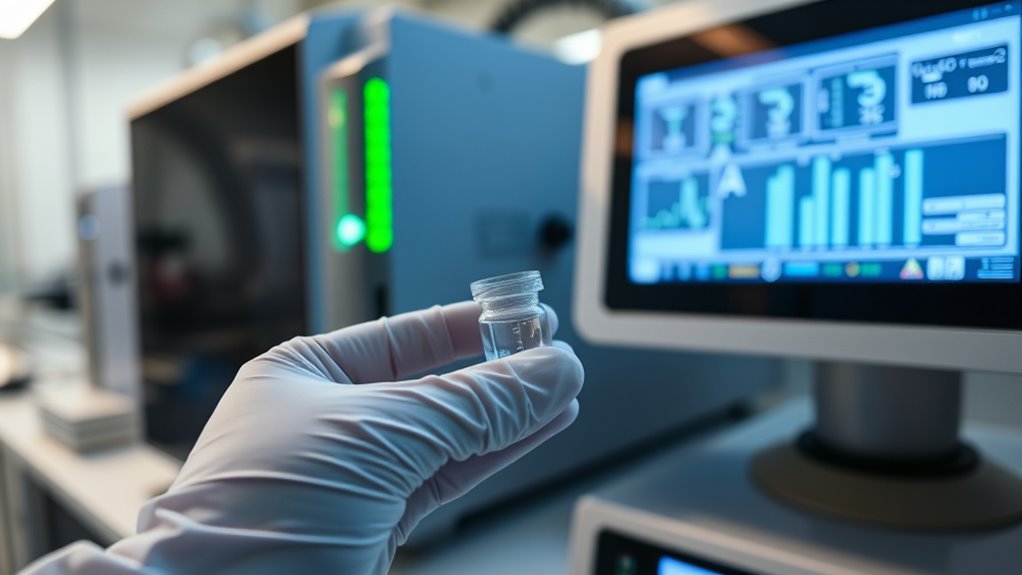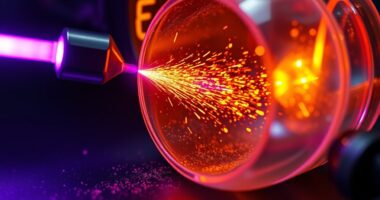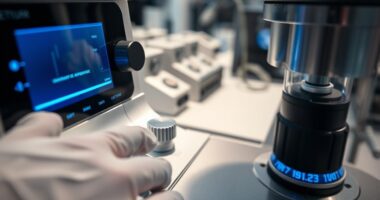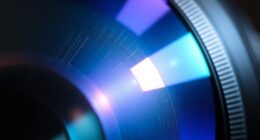Raman spectroscopy is a powerful tool for pharmaceutical quality control because it offers fast, non-destructive analysis of raw materials and finished products. It provides detailed molecular information, allowing you to verify ingredient identity, detect impurities, and distinguish between different forms. Its quick, on-site capabilities help catch issues early, reducing waste and ensuring safety. If you want to discover how this technology can strengthen your quality assurance processes, there’s more to explore ahead.
Key Takeaways
- Raman spectroscopy provides rapid, non-destructive identification and purity analysis of raw materials and finished pharmaceutical products.
- It offers spectral fingerprinting for accurate verification of ingredients, polymorphs, and detection of counterfeits.
- The technique enables real-time, on-site quality checks, reducing production delays and ensuring consistent product quality.
- Its high sensitivity detects impurities and substandard batches without compromising sample integrity.
- Minimal sample preparation allows seamless integration into existing QC workflows, supporting proactive manufacturing decisions.
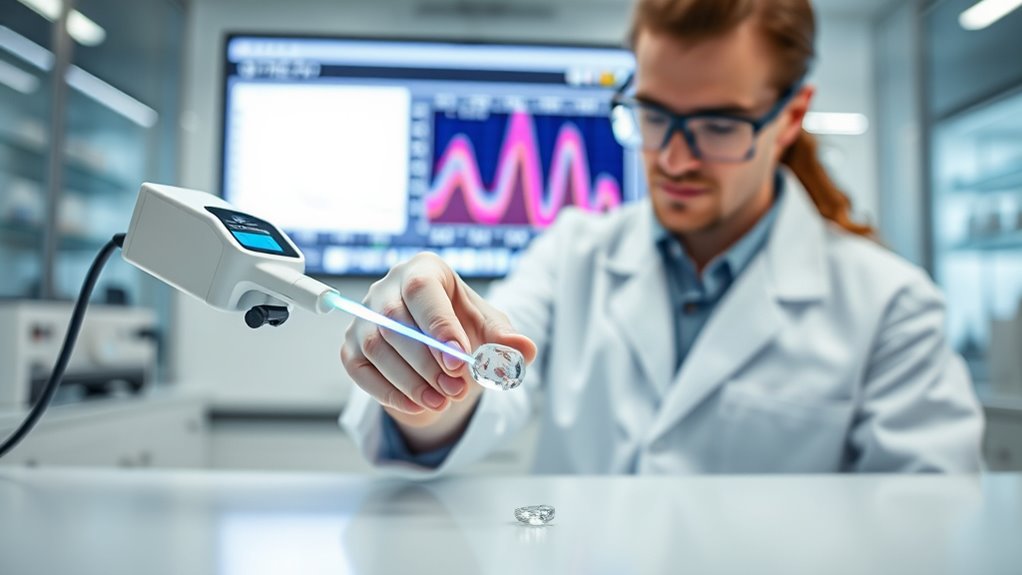
Raman spectroscopy has become an indispensable tool in pharmaceutical quality control because it enables quick and non-destructive analysis of raw materials and finished products. With its ability to generate detailed molecular information, you can identify compounds accurately and efficiently. One of the key advantages lies in spectral fingerprinting, where each substance exhibits a unique spectral pattern. This fingerprint acts like a molecular signature, allowing you to distinguish between authentic ingredients and potential adulterants. When you perform spectral fingerprinting, you’re effectively verifying the identity and purity of raw materials before they proceed further in manufacturing, reducing the risk of contamination or substandard products reaching consumers. Additionally, the technique’s ability to detect subtle molecular differences enhances its effectiveness in identifying impurities or variations that could impact product quality.
Raman spectroscopy ensures accurate identification and purity verification of raw materials through unique spectral fingerprints.
Rapid screening is another critical benefit of Raman spectroscopy in pharmaceuticals. Instead of relying on traditional, time-consuming methods like chromatography or wet chemistry, you can quickly assess samples on-site. This speed makes it feasible to perform real-time quality checks during production, rather than waiting days for lab results. Rapid screening with Raman spectroscopy helps you catch deviations early, preventing costly batch failures and minimizing downtime. As a result, you can maintain a steady manufacturing process and ensure consistent product quality, which is crucial for regulatory compliance and patient safety.
Using Raman spectroscopy for spectral fingerprinting and rapid screening also enhances your ability to detect polymorphs, counterfeit drugs, or dosage variations. Different polymorphs of the same drug may have distinct spectral signatures, and recognizing these differences helps you ensure proper formulation. Additionally, Raman’s sensitivity allows you to identify counterfeit products or substandard batches swiftly, protecting your brand reputation and patient health. The non-destructive nature of the technique means you don’t need to remove samples from their packaging or destroy them, saving time and resources while maintaining sample integrity.
Furthermore, because Raman spectroscopy requires minimal sample preparation, it integrates seamlessly into existing quality control workflows. You can perform inline or at-line testing, providing immediate feedback during manufacturing. This real-time analysis supports a proactive approach to quality assurance, enabling you to make informed decisions quickly. The technique’s versatility also means it can be used across various stages of production, from raw material verification to final product inspection, creating a robust quality control system.
Frequently Asked Questions
How Does Raman Spectroscopy Compare to Other Pharmaceutical Analytical Techniques?
You find Raman spectroscopy advantageous because it offers high analytical precision and minimal sample preparation. Compared to other techniques like HPLC or UV-Vis, it’s faster, non-destructive, and requires no dyes or labels. This makes it ideal for real-time quality control. While some methods may have higher sensitivity, Raman’s ability to analyze samples directly, with little interference, sets it apart in pharmaceutical analysis.
What Are the Limitations of Raman Spectroscopy in Pharmaceutical Analysis?
You should be aware that Raman spectroscopy has limitations like being affected by sample matrix complexities, which can obscure spectral signals. Fluorescence interference is another challenge, often overpowering the Raman signal and reducing accuracy. These issues make it difficult to analyze certain pharmaceutical samples, especially those with complex compositions or high fluorescence. Despite its advantages, you need to contemplate these limitations when applying Raman spectroscopy for pharmaceutical analysis.
Can Raman Spectroscopy Detect Counterfeit or Adulterated Medicines?
You can use Raman spectroscopy for counterfeit detection and adulteration identification, but it’s not foolproof. While it quickly reveals discrepancies in chemical composition, skilled counterfeiters may mimic genuine spectra, making it hard to detect subtle adulterations. So, you gain a powerful tool, yet it should be part of an all-inclusive approach to guarantee medicine authenticity, not the sole solution. Trust, but verify with multiple methods.
How Cost-Effective Is Implementing Raman Spectroscopy in Quality Control Labs?
Implementing Raman spectroscopy can be highly cost-effective for your quality control labs. It reduces costs by cutting down sample preparation time and minimizing reagent use, leading to significant cost reductions. Additionally, it boosts operational efficiency by providing rapid, non-destructive analysis, allowing you to quickly identify quality issues. While initial investment might be substantial, the long-term savings and improved accuracy make it a smart choice for optimizing your pharmaceutical quality control processes.
What Training Is Required for Technicians to Operate Raman Spectrometers?
You need hands-on training to operate Raman spectrometers effectively, focusing on instrument setup, calibration, and data interpretation. Technicians should complete specific certification requirements to make sure they understand safety protocols and proper procedures. This training typically involves practical sessions and assessments to confirm competence. By doing so, you ensure your team can confidently and accurately perform measurements, maintaining high-quality standards in pharmaceutical quality control processes.
Conclusion
In summary, Raman spectroscopy is a game-changer in pharmaceutical quality control, offering precision that’s almost supernatural. You can quickly identify and verify raw materials, ensuring products meet the highest standards. Its non-destructive nature means you preserve valuable samples while catching issues early. Embrace this powerful tool, and you’ll stay ahead in the race for flawless medicines—because relying on Raman spectroscopy is like wielding a superhero’s secret weapon in your quality assurance arsenal.
